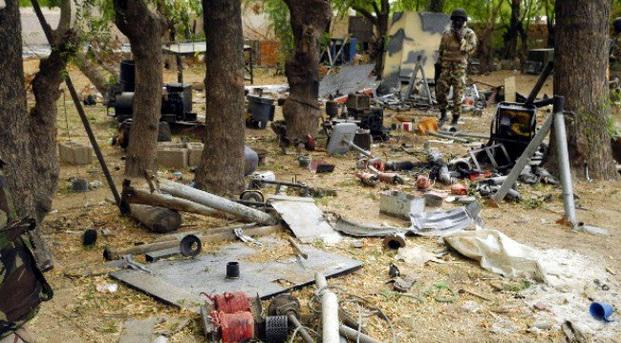Chigozie Chikere
Since 2005, Nigeria’s Federal Ministry of Aviation has had no fewer that six Ministers. Three of them lasted less than a year. The self-serving Femi Fani-Kayode who was dismissed in 2007 managed a grande total of 209 days. Particularly dispiriting about Fani-kayode’s dismissal is that it looked as if it marked the beginning of something new in the ministry. He became the first minister of aviation to be arrested, detained, and arraigned by the Economic and Financial Crimes Commission, EFCC. His tenure had turned out to be tainted by scandal and allegations of fraud.
Nigeria’s Minister of Aviation, Stella Oduah
Much of the responsibility for the mess belongs to Fani-Kayode. The man who lays claim to being the most successful aviation minister for Nigeria since 2002 had shown a breathtaking lack of leadership. Although there was no record of plane crash during his stint at the ministry, which he attributes to hard work and prayers, the ministry’s greatest undoing has been over Fani-kayode’s own murky financial affairs which climaxed at the Federal Government’s loss of a whopping 19.5bn Naira Aviation Intervention Fund.
Aviation Intervention Fund, one of the recommendations of the Paul Dike Committee was floated by the Central Bank of Nigeria, CBN to salvage the aviation sector. The fund was intended, among other reasons, to take care of infrastructure of four of Nigeria’s international airports. Again, it was to be made available to airline operators as long term soft loans for upgrading their operations.
Before Fani-Kayode’s appointment in 2006, Professor Babalola Borishade had served sixteen months as minister for aviation and recorded five major plane crashes in which 453 persons perished. This record appeared to be a rehash of Borishade’s woeful performance as education minister between 2001 and 2003. As education minister, Borishade had humiliated the Academic Staff Union of Universities, ASUU and devalued university education. His only legacy remains the closure of Nigerian universities for seven months. And so after the ADC Flight 53 crash in October 2006, President Olusegun Obasanjo had no option than bow to pressure and ease him out of office as aviation minister.
Since Fani-Kayode’s dismissal in 2007, four other ministers have served in the ministry among who is the current and substantive Minister for Aviation, Princess Stella Oduah.
The crash of Dana Air Flight 992 of June 3, 2012 in Lagos and subsequent ones, up to the Associated Airlines Flight 361 disaster of October 3, has drawn the attention of Nigerians to the resurgence of plane crashes. Thus addressing the Senate in plenary on October 9, the Chairman Senate Committee on Aviation, Senator Hope Uzodinma described the ugly situation as suggestive of a deep-seated system problem that must be unraveled and resolved in order to avert further and unnecessary loss of lives. The Senate had summoned the Aviation Minister and the Directors-General of Nigerian Civil Aviation Authority, NCAA and of National Airspace Management Agency, NAMA to explain the resurgence.
While the Deputy Senate president, Senator Ike Ekweremadu, had explained that the essence of the summons was not to indict but for the ministry to partner with the National Assembly in the quest for safer airspace, Nigerians at some quarters including Femi-Kayode have called for the sack of Stella Oduah as Aviation Minister. The question for Fani-Kayode and the rest is whether reports of air mishaps means that the huge capital projects executed in the aviation sector since 2011 including the refinancing of the once siphoned Aviation Intervention Fund and the zero import duty policy for aviation spare parts has been a misconceived disaster.
The answer is of interest not just within the aviation ministry. Such is the merry-go-round of ministers that it is easy to assume that whoever runs the show makes no difference to the performance of one of Nigeria’s most critical ministries in the service sector. Now Oduah’s performance in the past two years is about to be eclipsed by the criticisms and aspersions of detractors who would stop at nothing in their clamour for the minister’s fall and for the perpetuation of the hire and fire syndrome.
But that dangerously underestimates the importance of aviation to Nigeria and the challenges the ministry is facing. With huge capital investments and the demand for more funding relative to the size and position of the industry among ministries and agencies involved in international business, the dearth of airlines that stand out for being profitable, international and growing, coupled with a crop of stubborn and insolvent investors to manage, the ministry has an efficiency time-bomb ticking underneath it. It may be able to source for funds to develop infrastructure and to bankroll investors comfortably for the time being, but the specter of plane crash serves as a reminder that stakeholders in the aviation industry need to deviate from this blame game now and allow the ministry consolidate for greater efficiency to stop the bomb from exploding.
What is more, stability in international business of any country depends to a large extent on efficiency and cost-effectiveness of the aviation industry, which acts as the vehicle for safe and easy air travel across long distances. The Economist of June 18, 2011 quoted the International Air Transport Association, IATA as saying that African airports are among the costliest in the world and offer shoddy service. This assessment indicates that running and service costs alongside service quality are the most significant variables for measuring efficiency of air services. Besides, if cost here should include human lives lost within the vicinity of airports, what impact then has leadership changes in Nigeria’s aviation ministry made in reducing air mishaps and improving efficiency prior to 2011? Nonetheless the report goes on to say safety has improved a lot, but not enough. Too many planes are old and tired to the point that European Union, EU had to ban some smaller African airlines from European airspace. Incidentally this was in2011 and much has improved since then.
In view of a recent string of mishaps, Nigeria recently scored above 65 per cent on airspace safety and was rated 12th safest aviation globally on International Civil Aviation Organisation, ICAO scale. There are also reliable evidences that Nigeria’s National Air Carrier which seized operation since September 2012 would take to the skies again before the end of October. This would, no doubt, address the issue of old and tired planes raised by IATA.
Some commentators have alleged that the only visible improvement in aviation infrastructure so far is on terminal rehabilitation. However this is far from the truth given the magnitude and quality of the safety-critical equipment and infrastructure as well as certified manpower that the present administration has put in place in the past two years. This ranges from remodeling of airport terminals across the country including the once-neglected Akanu Ibiam International Airport Enugu to Total radar Coverage of Nigeria, TRACON, Airfield lighting and Multilateration equipment, Wind shear alert systems, and several other state-of-the-art electronic navigation and landing aids, as well as NCAA’s Revised Civil Aviation Policy which places high premium on safety.
Reports from the Accident Investigation and Prevention Bureau, AIPB reveal that Pilot error was responsible for the embarrassing crash of Associated Airlines Flight 361. So, contrary to insinuations about leadership failure, the agency explained that the preliminary readout and analysis of the flight recorder indicated that the aircraft was in bad shape technically yet the Pilot ignored the warning from the onboard computer voice.
However far-fetched it seems at this sorry juncture, the aviation crisis presents a chance to progress to a new sort of strategy, based more around policies than personalities. Besides its fiscal problems, the industry has a vast array of ageing infrastructure that will be a draw on the public purse. Presently, there are 22 airports operated by the Federal Airports Authority of Nigeria, FAAN and Governorship candidates in some states are promising more, yet the airports can hardly pay for their own maintenance. Past administrations with their hire and fire approach have failed utterly to deal with these problems. But President Goodluck Jonathan by means of the quantum and quality equipment and infrastructure he has put in place at the airports so far, coupled with the creation of a bailout fund to assist airlines in strengthening their fleet and becoming competitive, has demonstrated a political will to put Nigeria’s aviation industry on track. The minister, however badly her ministry has fared in the news recently, should capitalise on that by forming strong and good working relationships with the presidency, aviation parastatals, industry stakeholders and the ministry’s technical and ideological peers, rather than joining issues with those who evince hostility toward her. Getting rid of obsolete aircrafts and non-performing airlines from Nigeria’s airspace would be a sign of real change.
There is hope therefore that aviation industry transformation having gone this far is an indication that the much envisaged reform is in the offing. The sad fact is that someone who during his tenure as aviation minister did not put in place any project, policies, institutional reform or safety infrastructure for prevention of air mishaps is leading the pack of critics and calling on good people of Nigeria to begin to view the aviation industry’s performance through his own blurred, skewed, distorted and obscure lenses.
Chigozie Chikere
Member, The Chartered Institute of Logistics & Transport, CILT Nigeria
22 Ijero Road, Ebute Metta West, Lagos














